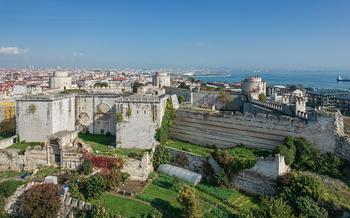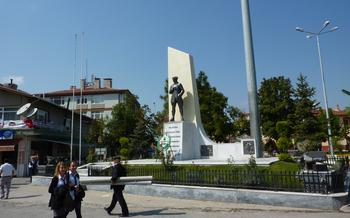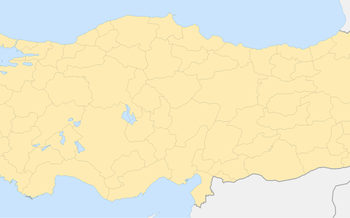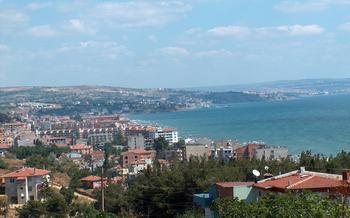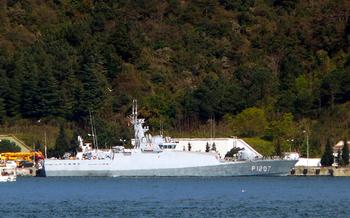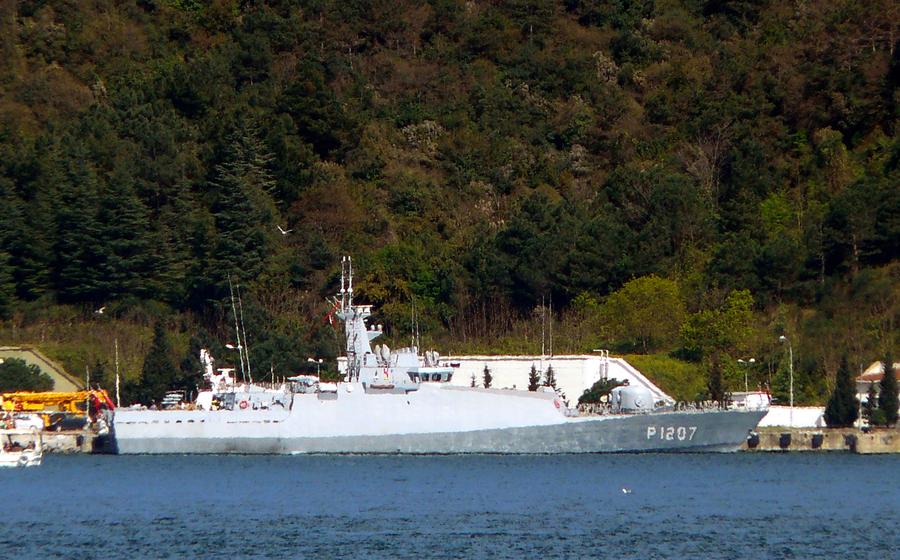
Barbaros Hayrettin Pasha Memorial
- Barbaros Hayrettin Pasha Memorial: A Tribute to a Legendary Seafarer
- Location and Accessibility:
- Historical Background
- Architectural Features:
- Unique Design:
- Symbolism in Design:
- Materials and Construction:
- Surrounding Area and Amenities
- Visiting Hours and Fees
- Things to Do at the Memorial
- Tips for Visitors
- Historical Context of Tekirdağ
- Barbaros Hayrettin Pasha's Early Life
- Barbaros Hayrettin Pasha's Naval Campaigns
- The Battle of Preveza in Detail
- Barbaros Hayrettin Pasha's Later Years
- Barbaros Hayrettin Pasha's Legacy
- Insider Tip: Discover the Hidden Gem of Barbaros Hayrettin Pasha's Birthplace
Barbaros Hayrettin Pasha Memorial: A Tribute to a Legendary Seafarer
Barbaros Hayrettin Pasha Memorial stands as a testament to the extraordinary life and accomplishments of the renowned Ottoman admiral. This magnificent tribute to his legacy offers visitors a chance to delve into the history of a legendary seafarer who shaped the course of maritime power in the Mediterranean. The memorial's striking architectural design, with its intricate details and symbolic elements, creates a captivating ambiance that complements the breathtaking vistas of the Marmara Sea. Its significance extends beyond mere commemoration, embodying the cultural and national pride of Turkey, making it a must-visit destination for anyone seeking to understand the country's deep-rooted maritime heritage.
Location and Accessibility:
The Barbaros Hayrettin Pasha Memorial is conveniently situated in the heart of Tekirdağ, a charming coastal city in northwestern Turkey. Its exact address is Barbaros Hayrettin Paşa Cd., 59000 Tekirdağ Merkez/Tekirdağ.
To reach the memorial, visitors have several transportation options at their disposal. Public transportation is a convenient and affordable choice, with buses and minibuses regularly servicing the area. For those who prefer the flexibility of a private vehicle, ample parking is available near the memorial, ensuring a hassle-free visit.
Historical Background
Barbaros Hayrettin Pasha, also known as Barbarossa, was a legendary Ottoman admiral who played a pivotal role in shaping the empire's naval power during the 16th century. His legacy extends far beyond his lifetime, leaving an indelible mark on maritime history.
One of Barbaros Hayrettin Pasha's most significant contributions was his strategic brilliance in the Battle of Preveza, fought in 153This pivotal battle marked a turning point in Ottoman naval dominance in the Mediterranean Sea. With his innovative tactics and expert leadership, Barbaros Hayrettin Pasha led the Ottoman fleet to a decisive victory against the formidable Holy League, an alliance of Christian powers.
The Battle of Preveza showcased Barbaros Hayrettin Pasha's mastery of naval warfare. He employed innovative tactics, such as using smaller, maneuverable galleys to outmaneuver the larger, slower ships of the Holy League. His victory not only secured Ottoman control over the eastern Mediterranean but also established his reputation as one of the greatest admirals of his time.
The Ottoman-Venetian rivalry, a long-standing conflict between the Ottoman Empire and the Republic of Venice, played a significant role in Barbaros Hayrettin Pasha's campaigns. Venice, a powerful maritime republic, sought to maintain its dominance over trade routes in the Mediterranean, posing a challenge to Ottoman expansion. Barbaros Hayrettin Pasha's victories against the Venetians, including the Battle of Preveza, weakened Venetian influence in the region and solidified Ottoman control over the eastern Mediterranean.
Architectural Features:
Unique Design:
The Barbaros Hayrettin Pasha Memorial stands out for its unique and striking architectural design. The memorial complex comprises a series of interconnected structures, each symbolizing a different aspect of Barbaros Hayrettin Pasha's life and achievements. The central structure, representing his naval prowess, is a tall, imposing tower that resembles a lighthouse, guiding sailors across the vast seas. Surrounding the tower are several smaller buildings, representing his strategic planning and leadership skills. These buildings house exhibits, displays, and artifacts related to Barbaros Hayrettin Pasha's life and campaigns.
Symbolism in Design:
The memorial's design incorporates various symbolic elements that pay homage to Barbaros Hayrettin Pasha's naval accomplishments. The tower's shape, reminiscent of a lighthouse, symbolizes his role as a guiding force in Ottoman naval power. The surrounding buildings, with their intricate designs and motifs, represent the different seas and regions where Barbaros Hayrettin Pasha led his campaigns. The use of blue tiles and turquoise accents evokes the colors of the Mediterranean Sea, where he achieved many of his victories.
Materials and Construction:
The Barbaros Hayrettin Pasha Memorial was constructed using high-quality materials and traditional building techniques. The exterior is adorned with intricate carvings and decorative elements, showcasing the craftsmanship and attention to detail that went into its creation. The interior spaces feature elegant marble floors, vaulted ceilings, and stained-glass windows, creating a sense of grandeur and reverence. The memorial's construction reflects the deep respect and admiration held for Barbaros Hayrettin Pasha and his contributions to Ottoman naval history.
Surrounding Area and Amenities
The Barbaros Hayrettin Pasha Memorial is situated amidst a vibrant area brimming with historical and cultural attractions. Just a stone's throw away lies the enchanting Tekirdağ Museum, a treasure trove of artifacts and exhibits that narrate the captivating story of Tekirdağ's rich history. For those seeking a spiritual experience, the historic Tekirdağ Grand Mosque stands tall, inviting visitors to immerse themselves in the tranquility and spirituality of Islamic architecture.
For a culinary adventure, the vicinity of the memorial offers a tantalizing array of dining options. Savor the authentic flavors of Turkish cuisine at traditional restaurants serving delectable dishes like freshly caught fish grilled to perfection, accompanied by the irresistible aroma of sizzling kebabs. International cuisine enthusiasts can indulge in a global culinary journey, with restaurants offering a diverse range of flavors from around the world.
If you wish to extend your stay and delve deeper into the region's allure, Tekirdağ boasts an array of comfortable hotels and guesthouses catering to every budget and preference. From charming boutique hotels nestled amidst picturesque streets to modern accommodations offering panoramic views of the Marmara Sea, there's a perfect haven for every traveler seeking a memorable stay.
Visiting Hours and Fees
The Barbaros Hayrettin Pasha Memorial welcomes visitors throughout the week, allowing them to delve into the life and accomplishments of this legendary admiral. The memorial's doors are open to the public from Tuesday to Sunday, between 9:00 AM and 5:00 PM. Visitors can explore the exhibits, admire the architectural beauty, and soak in the scenic vistas at their own pace.
General admission to the memorial is free of charge, making it an accessible destination for all. Guided tours are also available for those who seek a more in-depth understanding of Barbaros Hayrettin Pasha's legacy and the significance of the memorial. These tours are led by knowledgeable guides who provide insights into the admiral's naval campaigns, strategic brilliance, and lasting impact on Turkish history. Whether exploring independently or opting for a guided tour, the Barbaros Hayrettin Pasha Memorial offers a captivating journey into the world of one of the most celebrated seafarers in history.
Things to Do at the Memorial
At the Barbaros Hayrettin Pasha Memorial, visitors can delve into the life and achievements of this legendary seafarer through a range of engaging exhibits and displays. These exhibits showcase Barbaros Hayrettin Pasha's naval tactics, strategies, and the pivotal role he played in shaping Ottoman maritime power.
Visitors can also explore the memorial's grounds, which offer breathtaking views of the Marmara Sea. The memorial's unique design and intricate details provide a visually stunning backdrop for capturing memorable photographs.
For those interested in learning more about naval history, the memorial features interactive exhibits and educational displays that delve into the rich maritime traditions of Turkey and the Mediterranean region. These exhibits provide insights into the challenges and triumphs faced by seafarers throughout history.
Whether you're a history buff, a naval enthusiast, or simply seeking a scenic and educational experience, the Barbaros Hayrettin Pasha Memorial offers a captivating journey into the life and legacy of one of the most renowned admirals in Mediterranean history.
Tips for Visitors
When visiting the Barbaros Hayrettin Pasha Memorial, it's essential to plan ahead and make the most of your experience. Here are some tips for visitors:
-
Plan Your Visit: Check the weather forecast and dress accordingly, as the coastal climate can be unpredictable. The memorial's location offers stunning views, but the weather can be chilly or windy, so layering is recommended.
-
Bring Essentials: Carry essentials like water, sunscreen, and comfortable footwear for exploring the memorial grounds. The memorial is extensive, and walking is involved, so proper footwear is crucial.
-
Photography Etiquette: Be respectful of other visitors and avoid using flash photography inside the memorial. The use of flash can be disruptive to other visitors and can damage the exhibits.
Historical Context of Tekirdağ
Tekirdağ boasts a rich and diverse history that dates back to ancient civilizations. Inhabited since prehistoric times, the region has witnessed the rise and fall of numerous empires, each leaving its unique mark on the city's landscape and culture.
During the Byzantine era, Tekirdağ was known as Rhaedestus and served as a significant port city. Its strategic location at the crossroads of the Marmara Sea and the Balkan Peninsula made it a vital hub for trade and commerce. The city's impressive fortifications, including the remnants of the ancient city walls, stand as a testament to its strategic importance during this period.
Tekirdağ's significance continued to grow during the Ottoman Empire. The city became a key naval base, playing a crucial role in the empire's maritime expansion and control of the Mediterranean Sea. The construction of the Tekirdağ shipyard, under the reign of Sultan Mehmed II, further solidified the city's status as a major naval center. The shipyard produced numerous warships, including galleys and galleons, which helped the Ottomans establish their naval supremacy in the region.
Tekirdağ's rich historical heritage is reflected in its diverse architectural landmarks, including mosques, churches, and historical buildings. These structures, many of which have been meticulously preserved, offer a glimpse into the city's past and the various cultures that have shaped its identity.
As a modern city, Tekirdağ continues to thrive, blending its rich history with a vibrant present. Its strategic location and diverse cultural heritage make it a fascinating destination for travelers seeking to explore Turkey's rich past and vibrant present.
Barbaros Hayrettin Pasha's Early Life
Barbaros Hayrettin Pasha's early life remains shrouded in mystery, with various accounts and legends surrounding his origins. According to popular tradition, he was born in the village of Yenice Vardar, Macedonia, in 147His given name was Hızır, and he was the son of a humble fisherman named Yakup Ağa. From a young age, Hızır displayed a keen interest in the sea and maritime affairs. He spent his childhood exploring the coastline and harbors of the region, learning the intricacies of sailing and navigation.
As a young man, Hızır embarked on a life of adventure and exploration. He joined a group of Mediterranean corsairs, known as the Barbary pirates, who operated out of North Africa. Under their tutelage, he honed his skills as a naval commander and strategist. He quickly rose through the ranks, gaining a reputation for his bravery, cunning, and tactical prowess.
Hızır's exploits as a corsair brought him into conflict with the powerful Christian navies of the Mediterranean. In particular, he became a thorn in the side of the Knights of St. John, a Catholic military order based on the island of Malta. His daring raids and successful attacks against their ships earned him the moniker "Barbarossa," meaning "Red Beard" in Italian.
These early experiences shaped Barbaros Hayrettin Pasha's character and prepared him for his future role as a legendary Ottoman admiral. His mastery of naval warfare, combined with his strategic brilliance and unwavering loyalty to the Ottoman Empire, would ultimately make him one of the most formidable figures in Mediterranean history.
Barbaros Hayrettin Pasha's Naval Campaigns
Barbaros Hayrettin Pasha's naval campaigns were marked by a series of decisive victories and strategic conquests that significantly shaped the balance of power in the Mediterranean Sea. Among his most notable achievements were:
-
The conquest of Algiers in 1516, which transformed the city into a key Ottoman stronghold and a base for naval operations in the western Mediterranean.
-
The Battle of Preveza in 1538, where Barbaros Hayrettin Pasha's innovative tactics and leadership led to a resounding victory over the Holy League, solidifying Ottoman naval dominance in the eastern Mediterranean.
-
The capture of Tunis in 1534 and its subsequent defense against a massive Habsburg counterattack, demonstrating Barbaros Hayrettin Pasha's strategic prowess and ability to withstand formidable challenges.
These campaigns not only expanded the Ottoman Empire's maritime reach but also secured its control over key trade routes and strategic territories, contributing to the empire's overall power and influence in the region.
The Battle of Preveza in Detail
In the epic Battle of Preveza, fought on September 28, 1538, Barbaros Hayrettin Pasha's strategic brilliance shone brightly against the formidable Holy League fleet, comprised of Venetian, Spanish, and Papal forces. Despite being outnumbered, Barbaros Hayrettin Pasha's Ottoman navy emerged victorious, cementing his reputation as a master tactician and a force to be reckoned with in Mediterranean naval warfare.
Opposing Forces:
The Holy League assembled a formidable armada, boasting over 600 ships, including galleys, galleons, and sailing ships, crewed by seasoned sailors from across Europe. Their firepower was unmatched, with over 2,000 cannons bristling from their decks.
In contrast, Barbaros Hayrettin Pasha commanded a fleet of approximately 120 galleys, each armed with an average of 20 cannons. Though smaller in number and firepower, his ships were highly maneuverable and well-trained, a testament to Barbaros Hayrettin Pasha's exceptional leadership and naval expertise.
Battle Tactics:
Barbaros Hayrettin Pasha, anticipating the Holy League's superior firepower, devised a cunning strategy to neutralize their advantage. He ordered his galleys to form a crescent-shaped formation, with the flanks slightly withdrawn. This allowed him to concentrate his firepower on the Holy League's center, while protecting his own flanks from encirclement.
As the battle commenced, Barbaros Hayrettin Pasha's galleys unleashed a devastating barrage of cannon fire, targeting the Holy League's larger ships. The Ottoman gunners, renowned for their accuracy, inflicted heavy damage on the enemy vessels, disabling many and causing panic among their crews.
Legacy of the Battle:
The Battle of Preveza was a resounding triumph for Barbaros Hayrettin Pasha and the Ottoman navy. The Holy League's fleet was routed, losing over 100 ships and thousands of men. This decisive victory secured Ottoman dominance in the Mediterranean for decades to come, shattering the myth of European naval invincibility.
Barbaros Hayrettin Pasha's strategic genius and tactical prowess were instrumental in this historic victory. His innovative tactics and unwavering determination earned him the respect and admiration of friend and foe alike, cementing his legacy as one of the greatest admirals in Mediterranean history.
Barbaros Hayrettin Pasha's Later Years
Following his triumph at Preveza, Barbaros Hayrettin Pasha's reputation and influence soared within the Ottoman Empire. He was bestowed with the prestigious title of Kapudan Pasha, the supreme commander of the Ottoman navy, a position he held for several years. His expertise and strategic prowess were instrumental in maintaining Ottoman naval dominance in the Mediterranean.
Barbaros Hayrettin Pasha played a pivotal role in developing and improving naval infrastructure throughout the empire. He oversaw the construction and expansion of shipyards, arsenals, and fortifications, ensuring that the Ottoman navy possessed the necessary resources and facilities to maintain its strength and efficiency. His contributions extended beyond military matters, as he also played a role in promoting trade and commerce, recognizing the importance of a robust maritime economy.
Barbaros Hayrettin Pasha's Legacy
Barbaros Hayrettin Pasha's fame as one of the most remarkable admirals in Mediterranean history extends far beyond his lifetime. His strategic brilliance, innovative tactics, and unwavering dedication to the Ottoman Empire left an indelible mark on naval warfare. His victories at sea not only secured Ottoman naval dominance but also played a crucial role in shaping the geopolitical landscape of the Mediterranean region.
Barbaros Hayrettin Pasha's legacy lives on as a source of inspiration for naval officers and seafarers around the world. His ability to turn the tide of battles against seemingly insurmountable odds, coupled with his unwavering loyalty to his sultan, continues to inspire generations of sailors and military strategists. His name remains synonymous with courage, leadership, and maritime prowess, forever etched in the annals of naval history.
Insider Tip: Discover the Hidden Gem of Barbaros Hayrettin Pasha's Birthplace
For a truly immersive experience, venture beyond the memorial and explore the quaint village of Bozcaada, believed to be the birthplace of Barbaros Hayrettin Pasha. This charming island, adorned with picturesque vineyards and serene beaches, offers a glimpse into the admiral's early life and the rich history of the region. Stroll through the narrow cobblestone streets, visit the local museum dedicated to Barbaros Hayrettin Pasha's life, and savor the authentic flavors of Turkish cuisine at one of the traditional restaurants. Bozcaada is a hidden gem that allows visitors to connect with the roots of this legendary seafarer and gain a deeper appreciation for his remarkable achievements.
